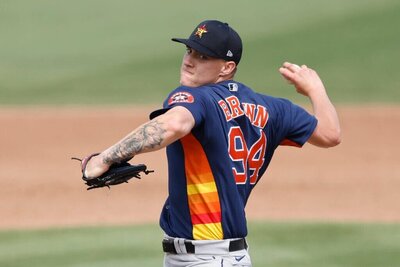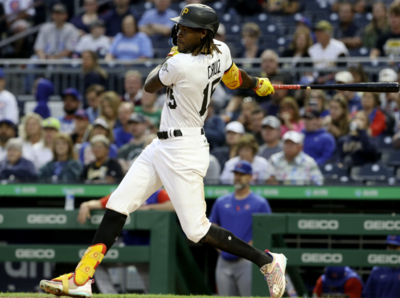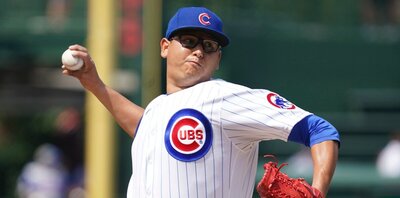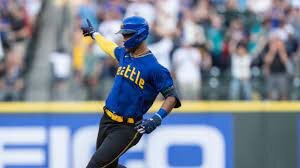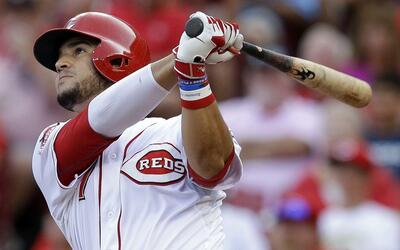Justin Maxwell (OF-HOU)- Maxwell went hitless in four plate appearances on Wednesday in the Astros loss. He has struggled for most of the year, and he struck out three times to see his slash line drop to .238/.309/.365. Known for his power, Maxwell has hit only one home run in his 139 plate appearances. With a 32.8 percent strikeout rate last year, Maxwell appeared to take a different approach in 2013. As a result he cut his swinging strike rate to 13 percent (a career low) while lowering his strikeout rate to 27.3 percent. However, he has been unable to drive the ball for most of the year. Maxwell's fly ball rate has fallen from 39.3 to 32 percent, but and his infield fly ball rate is at 25 percent for the season. All the infield fly balls explain his career worst 3.6 percent HR/FB ratio.
Jered Weaver (SP-LAA)- Weaver delivered a dominating performance on Wednesday against the Twins to improve his record to 5-5 for the year. He threw eight shutout innings in which he allowed only two hits and one walk while striking out nine. Weaver managed to lower his ERA to 2.98, and his 3.48 FIP and 4.14 xFIP are actually an improvement over last season. Weaver has managed to induce a 10.2 percent swinging strike rate this year (second best of his career) despite diminished velocity (86.7 mph with FB). He has shown a real skill in keeping his BABIP and HR/FB ratio down with weak fly balls. His 17.7 percent infield fly ball rate is career best, and I would not be surprised to see his BABIP (.279) to continue to decrease over time. Many other starters will continue to get the headlines, but Weaver continues to be one of the more reliable starters in the league for owners.
Wil Myers (RF-TB)- Myers went 2-for-4 with a walk, two RBI and a stolen base to help lead the Rays to a 5-1 victory over the Red Sox. The stolen base was his fourth of the season, and he is now hitting .322/.351/.496 with five home runs since being called up from Triple-A last month. It has not been a perfect first month for Myers. He has continued to strikeout a little bit too often (23.7 percent rate), and his plate discipline has not been as strong as it was during his minor league career. His walk last night brought his overall rate to 5.3 percent. However, those thinking his strong start is based purely on luck are mistaken. His .386 BABIP is high, but he came into the game with a 25 percent line drive rate. Myers will see his BABIP regress, but I still think he can finish a .285/.329/.470 type by the end of the year with 13-15 home runs.
Casey Janssen (RP-TOR)- Janssen blew his second save of the year on Wednesday due in large part to a key error by Colby Rasmus. He did not pitch that poorly allowing one walk and a single while striking out two in his inning of work. The run he allowed was unearned, and Janssen now has a 2.51 ERA for the season. His 2.40 FIP and 3.08 xFIP indicate that he is still one of the better closers in the American League. His velocity has dropped on both his fastball and cutter, which has resulted in a lower swinging strike rate (7.9 percent) and strikeout rate (8.91 K/9). However, Janssen has been able to improve his ground ball rate from 42.5 to 49.6 percent (closer to his career rate). Janssen's HR/FB ratio of 4 percent is due to regress, as is his .235 BABIP. However, he should continue to pitch to an ERA below 3.00 considering his peripherals.
John Danks (SP-CHW)- Danks struggled through another outing on Wednesday night to see his record fall to 2-8, as the White Sox lost by the score of 6-2 to the Tigers. Danks allowed six runs on eleven hits (three home runs) and one walk while striking out three in seven innings of work. The left-hander now has an ERA of 4.81 for the season due in large part o his 18.1 percent HR/FB ratio. As a result, his xFIP of 3.87 suggests there will be some improvement in the second half of the year, but there are still plenty of concerns. His shoulder surgery from last year has zapped a lot of his velocity, as his fastball is currently averaging 88.8 mph (90.8 mph for career). This would explain the increase in home runs, but Danks is also posting the second best swinging strike rate of his career (9.5 percent). His ERA will eventually improve when his HR/FB regresses, but his walk rate (1.06 BB/9) and BABIP (.276) are also due for some regression too.
Follow me on Twitter for baseball info and other miscellaneous ramblings.


